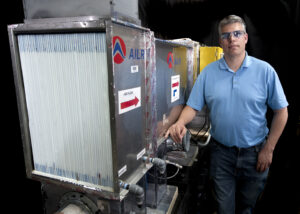Commercial Buildings, Housing
December 5, 2023—When startups join the Wells Fargo Innovation Incubator (IN2) program, they get assigned a principal investigator (PI) to help guide them through the process. This person is the startup’s go-to contact regarding technical questions and research advancement at the National Renewable Energy Laboratory (NREL) or the Donald Danforth Plant Science Center.
NREL Senior Mechanical Engineer and Researcher Eric Kozubal has been a stalwart PI for several IN2 startups. After 21 years at the lab, Kozubal says of the countless projects he has worked on, at this point, whatever he works on currently is always his favorite.
“I think what I’m working on now is a culmination of everything I’ve done in the past,” Eric said. “My favorite project is always my current project. What’s neat is I get to draw upon a lot of my past research.”
When Eric first joined NREL as a graduate student, he developed a technology that he says went nowhere. It was a novel heat exchanger for cooling power plants.
“But it was too expensive and didn’t work for that application,” he said. “So, I just shelved it.”

March 14, 2012 – Eric Kozubal stands next to a 1st generation, prototype DEVAP air conditioner that demonstrates a proof of performance. (Photo by Dennis Schroeder / NREL)
About 16 or 17 years later, he dug that project out of the archives and is using the same core ideas but implementing them into highly efficient air conditioning applications in collaboration with a startup company, Blue Frontier. Blue Frontier began working with NREL early in its lifecycle and continued that work with the help of IN2.
“It’s fun to think that something I had done so long ago, I can now implement and work on even more,” Eric said.
Eric works on several projects simultaneously focused on improving the overall efficiency of buildings. In addition to the Blue Frontier partnership, he is working on a demonstration project with Copeland. Copeland purchased the technology from a startup company, 7AC Technologies—another IN2 participant from Cohort 2 who had been working with NREL since 2010 to develop desiccant-based air conditioning systems.
A desiccant is a material that can attract and hold water and is very useful when designing next-generation, efficient dehumidification systems (such as dedicated outdoor air ventilation systems). Today’s dehumidifiers often use solid desiccants to keep products dry and absorb moisture, but managing efficient energy consumption in these systems is difficult. However, Copeland uses a liquid desiccant (a lithium chloride saltwater mixture) instead, which can absorb water from the air. A successful liquid desiccant is much easier to manage and enables more efficient system designs.
“Many of these companies I have worked with, I was able to help them solve a specific technical challenge or uncover untapped potential,” he said. “It’s important to work with both established companies and startups; however, your established, large manufacturers of HVAC equipment have limited research budgets and ability to change their product. They are looking to make small, easy tweaks. Startups often don’t have this constraint. Their whole premise is to disrupt the market. They can be a very powerful way of introducing novel, innovative technologies that just haven’t been developed enough for a large company to adopt. This is a vehicle that can really bring upon large step changes in technology, rather than incremental changes.”
Eric remains incredibly optimistic about helping the energy transition in buildings.
“The old thought was that buildings were always the consumer of energy and a big cause for CO2 emissions,” he said. “But the technologies we’re developing now can better take advantage of renewable energy and assist a low-carbon grid. We are developing ways to store energy in thermal batteries and liquid desiccants, not lithium-ion, which means we don’t have to mine as much precious metals. Buildings have a big role to play in decarbonization. For heating and cooling specifically, we’ve been using the same technologies for more than 100 years since it was first commercialized. I can’t think of many American technology sectors that haven’t been significantly changed in 100 years, but I’m confident we are developing technologies that will soon disrupt HVAC markets.”
